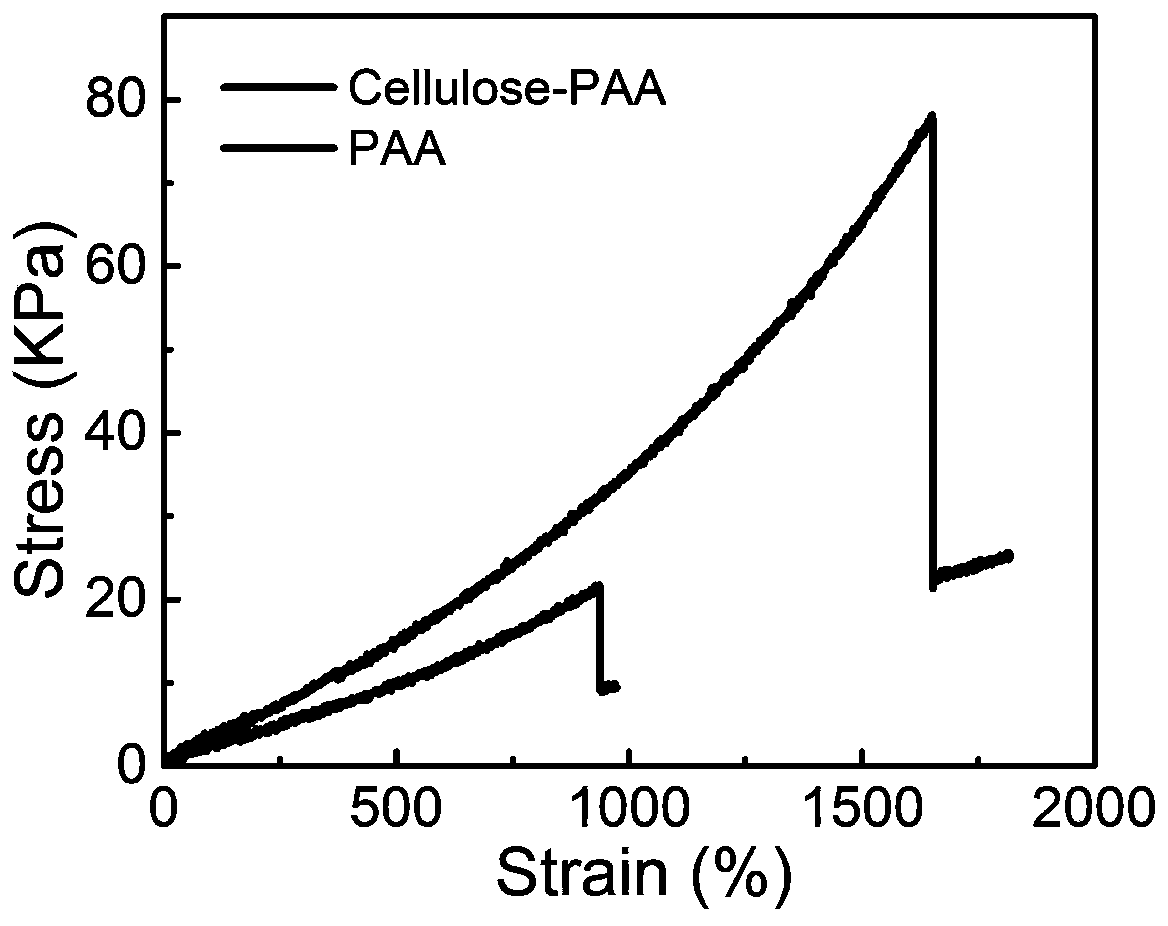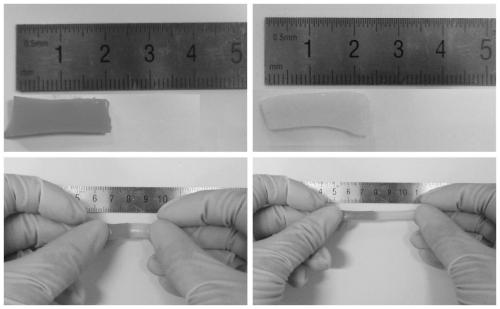Nanocellulose-polymer composite hydrogel as well as preparation method and application thereof
A nanocellulose and composite hydrogel technology, applied in electromagnetic measurement devices, electric/magnetic solid deformation measurement, etc., can solve the problems of easy degradation and poor stability, and achieve the effects of simple operation, low cost and wide source.
- Summary
- Abstract
- Description
- Claims
- Application Information
AI Technical Summary
Problems solved by technology
Method used
Image
Examples
Embodiment 1
[0038] A preparation method of nanocellulose-polymer composite hydrogel, comprising the steps of:
[0039] 1) preparing a cellulose nanoparticle dispersion with a mass fraction of 10%;
[0040] 2) Add Fenton's reagent to the cellulose nanoparticle dispersion, the concentration of Fenton's reagent in the system is 30mmol / L, and stir for 5min to form the first mixed solution;
[0041] 3) Add acrylic acid and N,N'-methylenebisacrylamide to the first mixed solution, the concentration of acrylic acid in the system is 3mol / L, and the concentration of N,N'-methylenebisacrylamide in the system is 50mmol / L, stirred for 10min to form the second mixed solution;
[0042] 4) Pour the second mixed solution into a polytetrafluoro mold and keep it at 60° C. for 2 hours to obtain a nanocellulose-polymer hydrogel.
[0043] The tensile mechanical properties of the nanocellulose-polymer hydrogel prepared in this example are as follows: figure 1 As shown, compared with pure polyacrylic acid hy...
Embodiment 2
[0045] A preparation method of nanocellulose-polymer composite hydrogel, comprising the steps of:
[0046] 1) preparing a mass fraction of 3% cellulose nanofiber dispersion;
[0047] 2) Add ammonium persulfate to the cellulose nanofiber dispersion, the concentration of ammonium persulfate in the system is 20mmol / L, and stir for 5min to form the first mixed solution;
[0048] 3) Add acrylamide and N,N'-methylenebisacrylamide to the first mixed solution, the concentration of acrylamide in the system is 3mol / L, and the concentration of N,N'-methylenebisacrylamide in the system 50mmol / L, stirred for 10min to form the second mixed solution;
[0049] 4) Pour the second mixed solution into a polytetrafluoro mold and keep it at 60° C. for 4 hours to obtain a nanocellulose-polymer hydrogel hydrogel.
Embodiment 3
[0051]A preparation method of nanocellulose-polymer composite hydrogel, comprising the steps of:
[0052] 1) preparing a cellulose nanofiber dispersion with a mass fraction of 1%;
[0053] 2) Add ammonium persulfate solution to the cellulose nanofiber dispersion, the concentration of ammonium persulfate in the system is 40mmol / L, and stir for 5min to form the first mixed solution;
[0054] 3) Add acrylamide, N-isopropylacrylamide and N,N'-methylenebisacrylamide to the first mixed solution, the concentration of acrylamide in the system is 1mol / L, and N-isopropylacrylamide The concentration in the system is 1mol / L, the concentration of N,N'-methylenebisacrylamide in the system is 40mmol / L, and stirred for 10min to form the second mixed solution;
[0055] 4) Pour the second mixed solution into a polytetrafluoro mold and keep it at 60° C. for 1 hour to obtain a nanocellulose-polymer hydrogel.
[0056] The self-healing properties of the nanocellulose-polymer hydrogel prepared in ...
PUM
 Login to View More
Login to View More Abstract
Description
Claims
Application Information
 Login to View More
Login to View More - R&D
- Intellectual Property
- Life Sciences
- Materials
- Tech Scout
- Unparalleled Data Quality
- Higher Quality Content
- 60% Fewer Hallucinations
Browse by: Latest US Patents, China's latest patents, Technical Efficacy Thesaurus, Application Domain, Technology Topic, Popular Technical Reports.
© 2025 PatSnap. All rights reserved.Legal|Privacy policy|Modern Slavery Act Transparency Statement|Sitemap|About US| Contact US: help@patsnap.com



